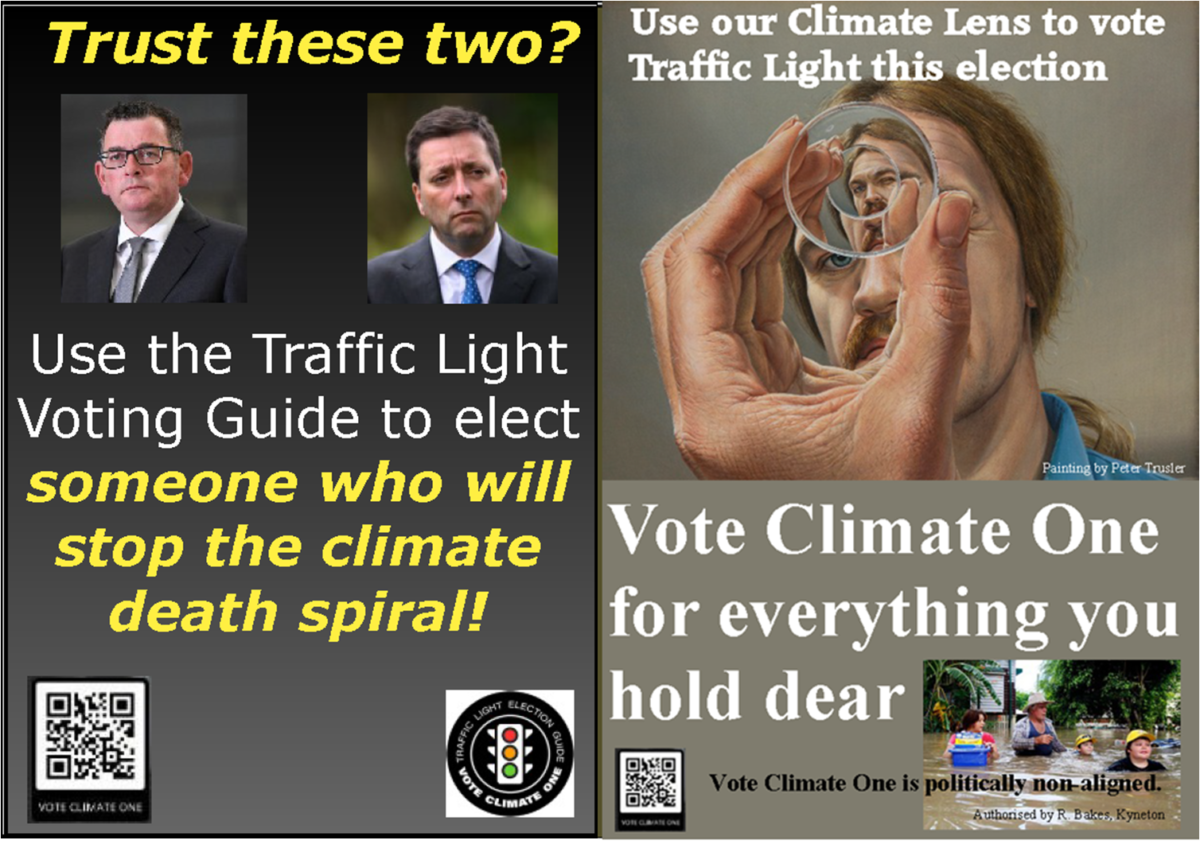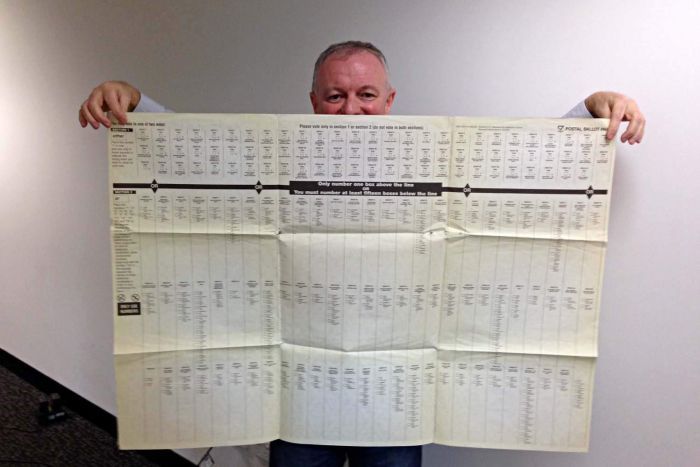Corruption of ‘Above the Line Voting’ for the Victorian Parliament’s upper house
Assessing parties and individuals running for Victoria’s Legislative Council (upper house) for Traffic Light ranking on climate policies reveals murky deals and unethical behaviors with strong odors of corruption. This corruption is made possible or even ‘encouraged’ by Victoria’s unique and arcane ‘group voting tickets’ (GVTs).
Group Voting Tickets defeat voter intentions
Some facts
Wikipedia gives a good explanation of how Group Voting Tickets work, and problems arising from them. Basically, they encourage establishment of a plethora of minor and micro parties and allow preference deals to be set up amongst groups of micro parties that more-or-less assure that at least one of the group is elected even with less than 1% of voter first preferences. This puts put single issue candidates from the far fringe into Parliament that otherwise wouldn’t have a hope of being elected in a fair proportional distribution of votes.
Ben Raue in Tally Room posts, “Victoria 2018 – the preference cabal is back” and “Vic 2018 – group voting tickets triumph over voters“, shows how GVTs grossly distorted the result of the 2018 State Election, with major deviations in seat counts from what might be expected from a ‘fair’ distribution of votes under proportional representation methods (i.e., D’Hondt and Saint-Laguë).
The most notable result in the election was that the Green voters were well and truly robbed. Although the Australian Greens had 4 seats in Parliament prior to the election and lost some votes going into the vote, after distribution of GVT preferences they ended up with only 1 seat, despite having 331,751 votes, coming 3rd in the count of first preferences. Eight (8) minor parties won 11 seats. Of these the largest number of preferences won by any one of them was, Hinch’s Justice Party with only 134,413 votes. Hinch’s Justice won 3 seats with 3.8% of the total votes, while the Greens won only 1 seat with 9.3% of the votes (the two ‘fair’ distribution methods both would have given 4 seats to Greens); and the Liberal Democrats won 2 seats with 3% of the vote. In other travesties, Sustainable Australia and Transport Matters Parties both won seats with substantially less than 1% of the first preference votes.
Quoting Raue,
If you look at the ratio of votes to seats, the discrepancy is massive. Transport Matters won one seat off a statewide vote of 22,228, while the Greens only won one seat off 331,751 votes.
My objection is not to small parties winning seats – but to the arbitrary and undemocratic way that this is decided. If the Victorian upper house was elected by the Saint-Laguë method (a variation on D’Hondt which gives a boost to smaller parties) we would have seen two less Labor members, one more Liberal, and three more Greens. But we would have still seen two members of Hinch’s party win seats, along with six others. This would have included members of the Democratic Labour Party and the Voluntary Euthanasia Party, both of whom received more votes than Sustainable Australia or Transport Matters but missed out thanks to unfavourable preference flows.
One of the most extreme results was Transport Matters in East Metro. They won off 0.6%, thanks to preferences from almost every other group. Eleven other candidates started ahead of them in the race for the final seat, with the Greens leading on 9%.
It’s also worth looking at the result in the South-Eastern Metro region, where the Liberal Democrats won off 0.84% of the primary vote. If every vote flowed according to the group voting tickets, the Transport Matters party would have won a second seat off 1.3%, but enough below-the-line votes flowed elsewhere to knock out TMP before the Greens, at which point preferences instead favoured the Lib Dems.
Read the complete article….
For formal results of the 2018 election, see the Victorian Electoral Commission (scroll down to Overall Upper House results and further to Individual Upper House results for the results in each electoral Region.
Chanel 6 News blog from 10 October (with more recent updates) lists candidates for all upper and lower house electorates with comments on changes of status. This item includes an interesting interview with the Deputy Leader of the Freedom Party, Aiden McLindon, discussing motivation and lack of ethics enabled by Victoria’s Group Voting Tickets in the Upper House:
Finally, there is a useful Age article from July 28 by Rachel Eddie, The blocker v the whisperer: Prizefight for preferences before state poll.
How can this affect you?
The Victorian State Legislative Council (Upper House) consists of 40 MPs, elected from eight multi-member electorates known as regions. Each region returns five members for a four-year term. How these are elected is unique to Victoria.
To understand how your one vote is apportioned to elect 5 different people, you need to understand what a Group Voting Ticket actually is. According to the Victorian Electoral Commission:
Two or more upper house candidates can register a group in a State election. Registering a group means that these candidates will be listed together on the ballot paper and will have a box above the line. Candidates who are not part of a group will appear below the line only.
…
Groups can contain members of one political party, multiple parties, or independent candidates. Groups appear before ungrouped candidates on the ballot paper and the group name appears above the line.
…
When completing the group registration form you can specify the order that members of your group will be listed on the ballot paper. Candidates can only be part of one group.
…
Group voting tickets are used to determine how your group wants to direct preferences when someone votes above the line.
…
The boxes above the line are groups of candidates that have registered one or more group voting tickets.
To vote above the line, write the number 1 in the box for the group you want to support.
When you vote above the line, your preferences will be decided by the group voting ticket.
A group voting ticket is a statement on how each party or group gives preferences to candidates. Every registered group voting ticket is made available on this website before an election and is also on display in every voting centre.
…
All group voting tickets will be published on [the VEC] website from Sunday 13 November.
…
Ungrouped independents are ONLY listed below the line.
In voting for the Legislative Council (Upper House) if you vote above the line, no numbers other than your 1 will be counted; and nothing you put below the line will be counted. i.e., there is no way you can vote above the line for an ungrouped independent.
If you want to vote for an ungrouped independent, you must vote below the line, and for your vote to count, you must number at least FIVE candidates below the line in your order of preference. Do not put any numbers above the line!
In 2018 Labor probably contributed largely to knocking out three of the four Greens candidates that would have won on a fair proportional vote: According to the Tally Room, “Labor is preferencing the Greens quite highly [so they look good to people concerned about the climate], but in every region they are preferencing a [micro party] candidate listed above ahead of the Greens, which means if they end up in a head-to-head race with the Greens at the end of the count, Labor’s preferences would help elect the little-known micro-party candidate.”
Personally, I would call this definitely unethical even though it entirely conforms to the provisions of the law!
This makes it clear why neither major party has shown any interest in reforming the ethically corrupt Group Voting Ticket law that wins them an extra upper house seat or so, and significantly reduces the number of Greens elected compared to what would result from a true proportional distribution. Keeping this law on the books also seems definitely unethical to me.
Summing up, if you are not a donkey or are voting only because you might be fined if you don’t, you will want your vote to elect candidates or parties who you think will support issues you deem to be important. If you vote above the line, your single vote will also go towards electing four other candidates below the top name on the party ticket – and you have NO SAY in deciding who these four candidates may be. Each party then allocates your vote to any other 4 candidates THE PARTY prefers. For large parties, this is why their tickets normally include 5 people. However, as the articles referenced above point out, based on largely hidden back-room preference deals among the parties, if you voted above the line your remaining 4 votes may be allocated by the group ticket you voted for to any one, such that the fifth choice may well go to a party whose policy is diametrically opposed to your interests.
E.g., if you voted above the line in the Eastern Metropolitan Region for Labor because you thought it has a better climate policy than the Liberals, Labor preferenced Transport Matters ahead of the Greens and successfully replaced the sitting Green member with the Transport Matters candidate:
EASTERN METROPOLITAN
2014: 3 Liberal, 1 Labor, 1 Green
ABC Calculator: 2 Liberal 2 Labor 1 Transport Matters
Projection: 2 Liberal 2 Labor 1 Transport Matters
Summary: In this count the major parties have two quotas each and Rodney Brian Barton (Transport Matters) appears to snowball from 0.62% of the vote to beat all others including the Greens (9.03%). Although Barton at one point falls to third-last, no threat to his victory has been identified.
Result: The provisional result is, as expected, 2 Liberal 2 Labor 1 Transport Matters.
Update: This result has been declared.
Your vote above the line for Labor because they appeared to have a better climate policy than the Liberals, shifted the balance of votes by two further away from reliable supporters of climate action.
How Vote Climate One can help you elect the candidates YOU want
Group Voting Tickets encourage a plethora of micro parties to nominate candidates, because several of them actually have a chance of being elected in the Upper House even with microscopic numbers of first preferences if they make the right preference deals. Thus, if you want to vote below the line you may end up having fifty to perhaps a hundred boxes to number if you want to allocate all your preferences. Our TRAFFIC LIGHT VOTING system, VOTING GUIDES – VIC and pro-forma ballots make doing this something you can do in a straight forward way and relatively quickly at home, so that all you need do in the polling booth is copy your pre-decided numbers from your Upper House pro-forma to the formal ballot paper. We also provide similar help with the Lower House ballot in every district. Use these tools, and you’ll then have time for your Democracy Sausage after if you vote on Polling Day.
Why are we at Vote Climate One going to all this effort to try to help you?
If we don’t stop global warming soon, we’ll have fueled enough positive feedbacks that runaway warming to Earth’s ‘Hothouse Hell’ state will virtually guarantee human extinction.
However, if we can help get climate savvy governments in power soon enough, they may be able to mobilize enough action so we can survive our accidental disruption of Earth’s Climate System so our kids and grandkids inherit a world they can live in….



